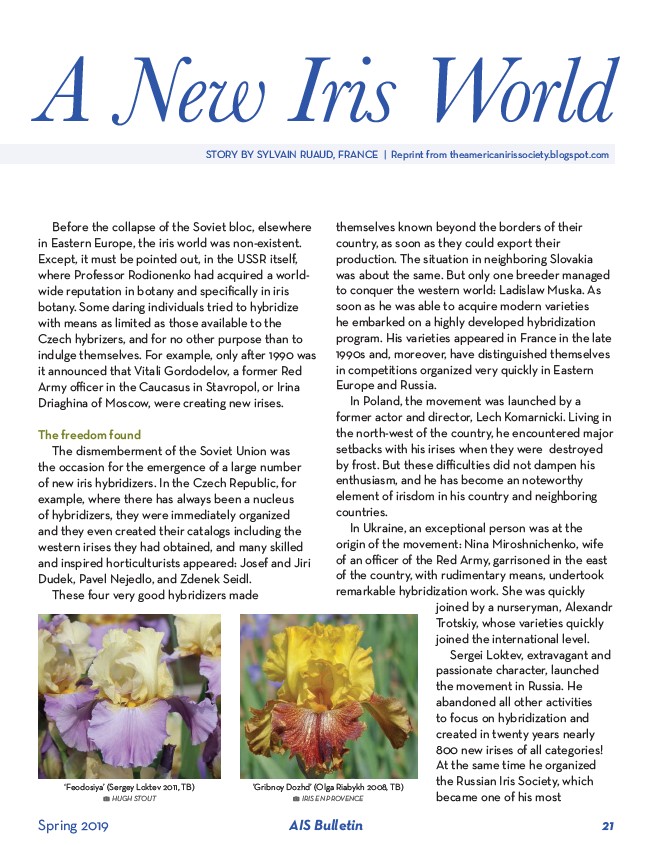
A New Iris World
STORY BY SYLVAIN RUAUD, FRANCE | Reprint from theamericanirissociety.blogspot.com
Before the collapse of the Soviet bloc, elsewhere
in Eastern Europe, the iris world was non-existent.
Except, it must be pointed out, in the USSR itself,
where Professor Rodionenko had acquired a worldwide
reputation in botany and specifically in iris
botany. Some daring individuals tried to hybridize
with means as limited as those available to the
Czech hybrizers, and for no other purpose than to
indulge themselves. For example, only after 1990 was
it announced that Vitali Gordodelov, a former Red
Army officer in the Caucasus in Stavropol, or Irina
Driaghina of Moscow, were creating new irises.
The freedom found
The dismemberment of the Soviet Union was
the occasion for the emergence of a large number
of new iris hybridizers. In the Czech Republic, for
example, where there has always been a nucleus
of hybridizers, they were immediately organized
and they even created their catalogs including the
western irises they had obtained, and many skilled
and inspired horticulturists appeared: Josef and Jiri
Dudek, Pavel Nejedlo, and Zdenek Seidl.
These four very good hybridizers made
themselves known beyond the borders of their
country, as soon as they could export their
production. The situation in neighboring Slovakia
was about the same. But only one breeder managed
to conquer the western world: Ladislaw Muska. As
soon as he was able to acquire modern varieties
he embarked on a highly developed hybridization
program. His varieties appeared in France in the late
1990s and, moreover, have distinguished themselves
in competitions organized very quickly in Eastern
Europe and Russia.
In Poland, the movement was launched by a
former actor and director, Lech Komarnicki. Living in
the north-west of the country, he encountered major
setbacks with his irises when they were destroyed
by frost. But these difficulties did not dampen his
enthusiasm, and he has become an noteworthy
element of irisdom in his country and neighboring
countries.
In Ukraine, an exceptional person was at the
origin of the movement: Nina Miroshnichenko, wife
of an officer of the Red Army, garrisoned in the east
of the country, with rudimentary means, undertook
remarkable hybridization work. She was quickly
joined by a nurseryman, Alexandr
Trotskiy, whose varieties quickly
joined the international level.
Sergei Loktev, extravagant and
passionate character, launched
the movement in Russia. He
abandoned all other activities
to focus on hybridization and
created in twenty years nearly
800 new irises of all categories!
At the same time he organized
the Russian Iris Society, which
became one of his most
’Gribnoy Dozhd’ (Olga Riabykh 2008, TB)
, IRIS EN PROVENCE
‘Feodosiya’ (Sergey Loktev 2011, TB)
, HUGH STOUT
Spring 2019 AIS Bulletin 21